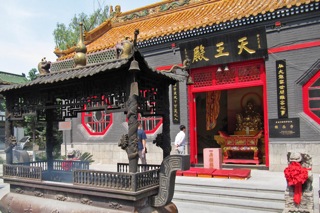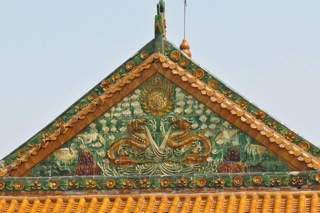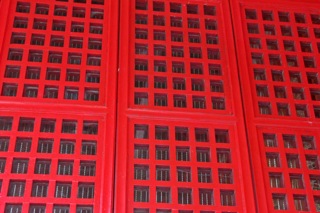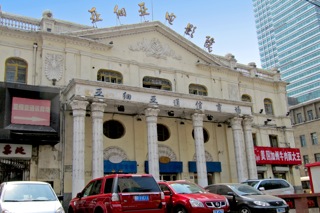


An excursion to the old Ji Le temple.On May 22nd we visit the Je Le temple in Harbin, founded in the early 1920s. It was evidently also known as Elysium or the Temple of Bliss. It was 168 years ago this night that a new era dawned on this world, and after sunset tonight I joined (in spirit) my co-religionists around the world in the observance of the Declaration of the Báb. I read prayers and mediated and generally had a quiet evening by myself here at Heilongjiang University. Earlier in the day, while at the temple, I had a lovely conversation about Buddhism with Zhao Chuanmin. She had thoughtfully copied for me a brief history and description of Buddhism and a section from a Buddhist dictionary, with all the English passages and words presented in Chinese, which I found very interesting. The weather conditions today were just perfect for a visit to the temple. The wind was blowing fiercely, and the elm trees were dropping their seeds, which floated and whirled around the courtyards, enhancing a feeling of energy and power. The wind also made the many bells hanging from the roof corners ring loudly like wind chimes, and so the sounds of bells filled the air. The incense smoke also blew around, perfuming the air. The Lilacs were also still scenting the air, although their blossoms were beginning to fade, so lilac blossoms were also dancing around in the air along with the elm seeds. Some workers were preparing the great hall for the Birthday of the Buddha, which will be celebrated in a few days. I suppose the temple will be more crowded then, for it certainly was not very busy today. |
Return to summer diary home page. |
Back to previous diary entry. Forward to next diary entry. |
 |
 |
 |
|
| The main gate to Ji Le Temple. | The First Hall. | In the larger image (click on the photo above) you can see the main hall. |
 |
 |
 |
|
| Splendid Chinese architectural detail. | I loved the pattern on the hall of the relic. | A view in the temple’s grounds. I was thinking of the crowds I’ve seen at some temples in Taiwan, or the general style of temples in Taiwan (some photographs linked from this page). This northern temple seemed more sedate and tranquil. |
 |
 |
 |
|
| This is the Church of the Holy Protection of the Virgin, one of the Russian Orthodox Churches in Harbin. | An old Russian Department Store in Harbin. | The oldest movie theater in Harbin. |
It is clear and evident to thee that all the Prophets are the Temples of the Cause of God, Who have appeared clothed in divers attire. If thou wilt observe with discriminating eyes, thou wilt behold Them all abiding in the same tabernacle, soaring in the same heaven, seated upon the same throne, uttering the same speech, and proclaiming the same Faith. (Book of Certitude, pages 153-154). Among persons who study the Baha’i writings deeply, there is some disagreement about the situation of Gautama Siddhartha Sakyamuni, the Buddha. The quotation above is held by some only to refer to the prophets in the traditions of Judiasm and Islam. But it’s fairly clear from the way the early Baha’is approached sophisticated Buddhists and Hindus (and drew converts or at least friends from those traditions), and also from some talks reportedly given by ‘Abdu'l-Baha in London, that the Buddha was included as a prophet of God in the tradition of Moses, Mohammad, Zoroaster, and Jesus. (‘Abdu'l-Baha is an authoritative source, but records of his talks given in Europe and North America are not always authoritative, as their accuracy can in some cases be doubted, unlike his writings). ‘Abdu'l-Baha is also reported to have said that the Buddhist Religion had lost much of the original teachings of the Buddha, a point that is disputed, or might reflect his understanding of the popular folk religions of East Asia rooted in Buddhist doctrines. At any rate, it’s my understanding that when Baha'u'llah or ‘Abdu'l-Baha were asked about the Buddha or Krishna or Confucious They tended not to give straight direct answers in writing about who was a prophet of God, but instead They stressed the underlying unity of the human quest for the Divine. I take from this the idea that it’s not a very important question whether the actual historical person upon which which the legends of the Buddha or Krishna are based was a Manifestation of God in the way Jesus or Mohammed were. The point is, Buddhism and Hinduism and Confucianism are all examples of humans striving to improve their condition, both individually and collectively. Such attempts are “of God” or “of the Divine” in some important respects, and the proper approach is to find what is good and useful in such religions and embrace it, rather than trying to put our categories of ”Manifestion of God“ or “Prophet bringing a Revelation from God” on persons whose actual condition is obscured by legend. Of course there must have been many Prophets in the tradition of Jesus lost to history, and there must have been many holy persons who were prophets in the style of Elijah or simply wise men like Rumi who spiritualized their societies without bringing new major Revelations who are also lost to history. My understanding is that Baha'u'llah appreciated the Sufi traditions holding that people approach the Divine and experience God in ways according to their capacities and abilities. For a person to waste time correcting someone whose understanding of the Divine is “incorrect” is slightly ridiculous. After all, Baha'u'llah revealed: ”Exalted, immeasurably exalted art Thou above the strivings of mortal humans to unravel Thy mystery, to describe Thy glory, or even to hint at the nature of Thine Essence.” Thus, I doubt the superstitious beliefs of simple people with their folk religion are significantly more distant from Truth than the most sophisticated theologies and insights of the saints. Even the atheistic scientists who are approaching the Divine through materialism and scientific cosmologies are hardly much further away from accurately understanding and appreciating God than correct-thinking Baha‘is who say their daily prayers and live their lives in accord with the principles and teachings. So anyway, I enjoy Buddhism, and I revere the Buddha and the various personifications of Divine attributes that serve in roles like saints, bodhisattvas, or gods in the Buddhist pantheon. Just as their are various interesting flavors in food, so there are flavors in religion or approaches to the Divine, and the point is to embrace rather than reject. Well, those are some religious musings. It was a holy day, and I did visit a Buddhist Temple, so this seemed approrpiate as a topic for this entry. |
Return to the summer diary home page. |
Back to previous diary entry. Forward to next diary entry. |